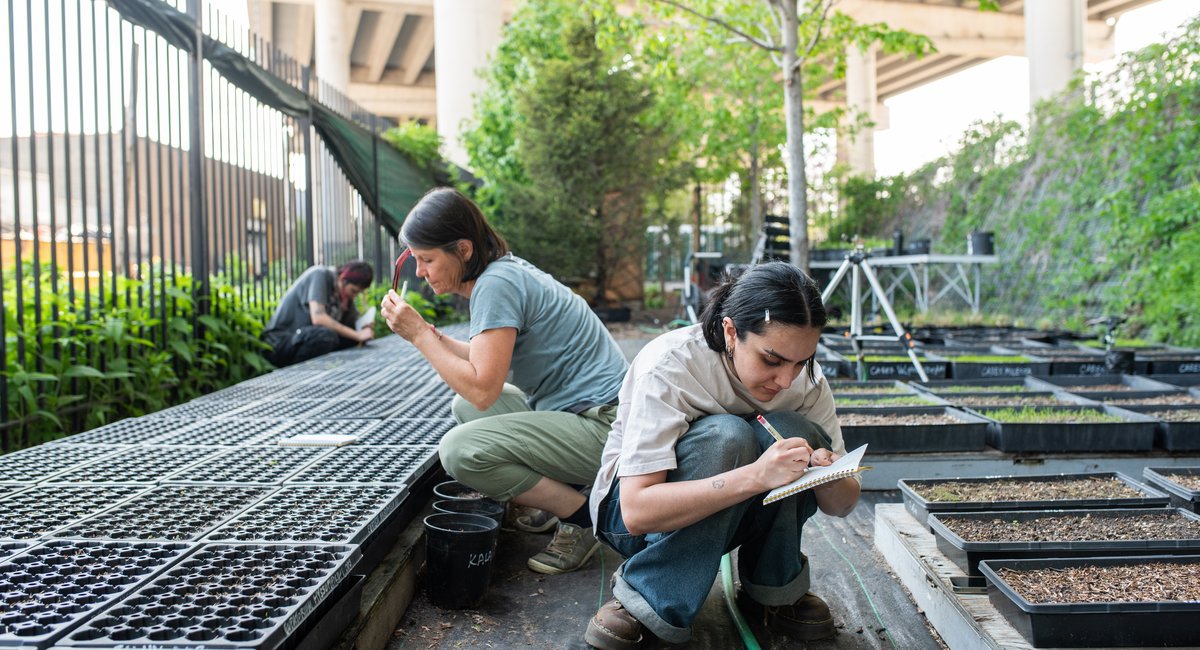A garden has begun to grow in the shadow of the Kosciuszko Bridge’s eastbound span, amid the grime of Brooklyn’s watery edge. The Native Nursery is at extreme odds with its surroundings, located within a Bermuda Triangle of three Superfund sites (the NuHart plumes, the Meeker Avenue plume and the Newtown Creek), bordered on all sides by some of the last bastions of Brooklyn’s industrial past.
The Native Nursery is the most recently opened portion of the 4-year-old Under the K Bridge Park, the privately operated public space that has been slowly transforming a particularly dirty, inaccessible and abandoned corner of Greenpoint into an urban oasis. The nursery has been in the works since late 2022 and held its first public event in 2023, but only launched its full slate of programming, including free plant distribution, this year.
The garden, which occupies a small slice of the 6.7-acre park, produces more than 100 different native-to-New York species from seed annually and distributes thousands of free plants to schools, community gardens and any individuals who may stop by.
Anyone is welcome to visit the Nursery to pick up plants whenever staff members are present and available to help, or during set times at its spring and fall distribution events, which are listed on its website. Plenty of area residents do, along with “the security guards, and the guys that build out the sets [for concerts at Under The K],” said Elizabeth Gilchrist, a veteran caretaker of New York’s hard-won greenspaces and the nursery’s current manager. One person simply saw that the area was green on Google Maps and came by to investigate, she said.
“They showed up because they said, ‘We saw this on Google Maps. We didn’t believe it was real,’” said Gilchrist, laughing with the kindness of a treehugger while ignoring the sudden, incessant beeping of a truck backing out of one of the nearby warehouses.
“All the ecological superstars have been showing up,” added Gilchrist as a black garden cat — Lou Reed — slunk over a few nearby pots. “I was really fangirling out.”
Who is an ecological superstar? Like, a plant influencer? No, no: Gilchrist reeled off the names of a variety of in-the-weeds New Yorkers who played vital roles in developing some of the city’s pre-eminent ecological spaces and programming, from GreenThumb and GrowNYC to the Eagle Street Garden.
Indeed, the nursery’s transformation is impressive even to an outsider, let alone the doyens of city greenery. The organized rows of potted plants contrast sharply with photos of what the under-bridge area looked like just two decades ago — a barren, boarded-up wasteland with nary a weed in sight.
“It’s wild how nature responds when you plant it,” Gilchrist said. “You can actually watch in real time, ecosystems rebuilding themselves.”
Brooklyn’s most unlikely green space
The nursery’s success comes despite challenging environmental conditions: It receives limited sunlight and shares the air with its pungent neighbors, including some of the city’s premier waste management businesses. It also lacks an irrigation system. But the smattering of volunteers and staffers who operate it have found ways to help Mother Nature reclaim this blip of land, namely by growing evolutionarily optimized, native-to-New-York species and fully utilizing their small square footage with a snazzily designed seed hill.
Financial conditions have also not been particularly welcoming: The nursery’s fixings are largely donated or sourced at discount from the complex network of enduringly committed nature groups that have long kept the city green, according to Katie Denny Horowitz, the executive director of the North Brooklyn Parks. Since 2003, the private nonprofit has run the larger Under the K space.
The nursery has shelves made of reclaimed wood courtesy of Tri-Lox, a private manufacturer; seeds from PECAN, a parks department-run nursery on Staten Island; soil largely from the NYC Clean Soil Bank, the nation’s only municipal clean soil exchange and distribution program; and pots from “any source that’s willing to give us pots,” Horowitz said.
The Native Nursery, Horowitz said, is nothing if not innovative, and thus stands as an excellent example of the creative thinking necessary to create new urban green spaces in years to come as development continues apace.
The crush of society feels far away while sitting in the nursery, which remains unvisited by anyone except staff and Lou Reed throughout the afternoon. After a time, the ever-present sound of traffic whizzing by overhead begins to sound like the ocean, the ambient machinery noises somehow fade, and a certain meditative solitude settles in.
“Really, if you’re looking for new open space, you have to think outside the box,” she said. Perhaps look under a bridge.

